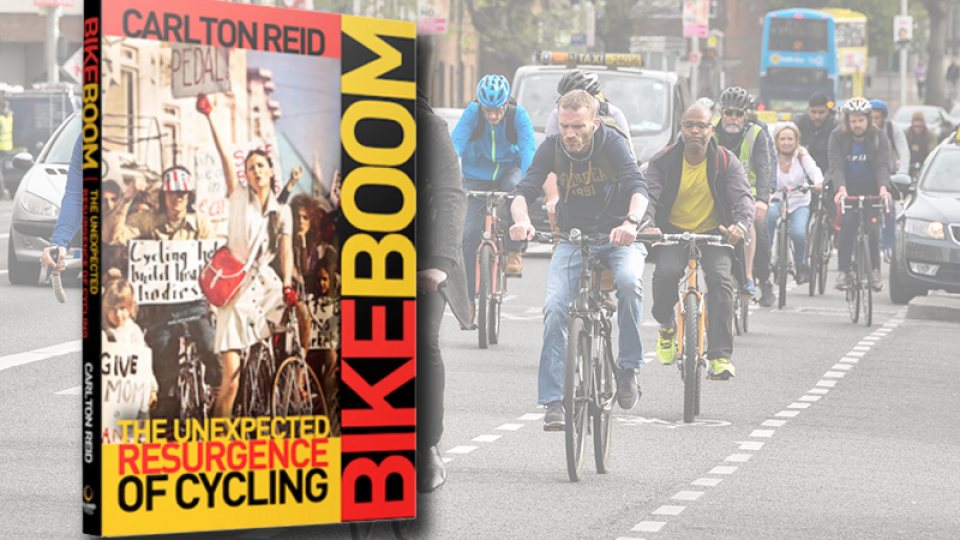Book Review: Bike Boom
Bike Boom: The Unexpected Resurgence of Cycling - by Carlton Reid
Book Review by Ciarán Ferrie
In June of 2017, the biannual Copenhagenize Index was published. The Index is a measure of the most bike-friendly cities in the world and, unsurprisingly, has been dominated by Amsterdam and Copenhagen since its inception in 2011. Dublin, for a time, fared well, scoring 9th place in the 2011 index in response to improvements that had taken place over the previous years, including the introduction of the dublinbikes scheme. After gradually slipping down the ranks it has now unfortunately dropped out of the top 20 altogether. In its report, the Index states that “after many years of progress, the city has stagnated and, to be honest, disappointed”.
Thankfully Carlton Reid has provided us with a roadmap to help us get back on track.
Bike Boom is a comprehensive history of cycling and cycling advocacy over the course of the twentieth century. It charts the ups and downs of cycling’s popularity both as a practical means of transport and as a recreational status symbol. Inevitably it also tracks the parallel development of the motor car and the impact that this has had on bicycle use and transport infrastructure. It looks at the at times well-meaning interventions that failed, like the California Cycleway, an ambitious elevated cycling highway built in 1899 but largely abandoned by the following year; or the attempts in 1930s Britain to introduce segregated cycleways which unfortunately hadn’t solved the problem of junctions, as cyclists were “pitched into the maelstrom of traffic at the most dangerous point”.
The book also demonstrates that the battle to ensure cycling remains a vital part of the transport infrastructure is never-ending, even in places with a strong cycling culture and that the provision of good cycling infrastructure does not in itself encourage people to cycle. The planned towns of Colombia, Maryland and Stevenage, UK were both designed to offer journey choices. Residents in both towns, given the choice, chose to drive. The case of Stevenage is particularly interesting. Designed by Eric Claxton based on Dutch models, the cycling infrastructure in the town is completely segregated from the roads. Claxton designed the cycleways, he said, not for cyclists but for people. Unfortunately, the people preferred the equally well-designed roads – in 2010 the cycling modal share was just 2.9%. The reason, Reid argues, is that unlike in similarly designed Dutch towns, car traffic was not constrained in anyway. As long as it is as convenient to drive as it is to cycle, it seems people will choose to drive.
The failure of Stevenage to live up to expectations as a cycling utopia has been used as an argument against the provision of cycling infrastructure. Why spend money on all these lanes when no-one will ever use them? But things are beginning to change, and the Netherlands remains the source of inspiration.
Reid refers to the Dutch concept of maakbaarheid, which he describes as “the need to be in control of one’s surroundings”, deriving from the particular geographic history of the Netherlands and the societal value placed on infrastructure as a communal asset and as a necessity for survival. The same ingenuity, hard work and vigilance required to reclaim large tracts of land from the sea has taught the Dutch to take “the long view of infrastructure” and to find “practical no-fuss solutions that benefit the common good”.
Any wonder then that the Netherlands has been the world’s leading bicycling nation since 1906. We have a long way to go to catch up but at least we know the path has already been laid for us.
Ciarán Ferrie is an architect and a founding member of cycling advocacy group I Bike Dublin.
A version of this review was originally published in Architecture Ireland Issue 294 July/August 2017
About the book:
Bike Boom: The Unexpected Resurgence of Cycling, by Carlton Reid | ISBN: 9781610918169 | Published by Island Press
In Bike Boom, journalist Carlton Reid uses history to shine a spotlight on the present and demonstrates how bicycling has the potential to grow even further, if the right measures are put in place by the politicians and planners of today and tomorrow. He explores the benefits and challenges of cycling, the roles of infrastructure and advocacy, and what we can learn from cities that have successfully supported and encouraged bike booms, including London; Davis, California; Montreal; Stevenage; Amsterdam; New York; and Copenhagen.
About the author:
Carlton Reid is Press Gazette Transport Journalist of the Year 2018. He is also a contributor to Forbes. He is also the author of “Roads Were Not Built for Cars”.
Help us do more for cycling in Dublin by becoming a member!

